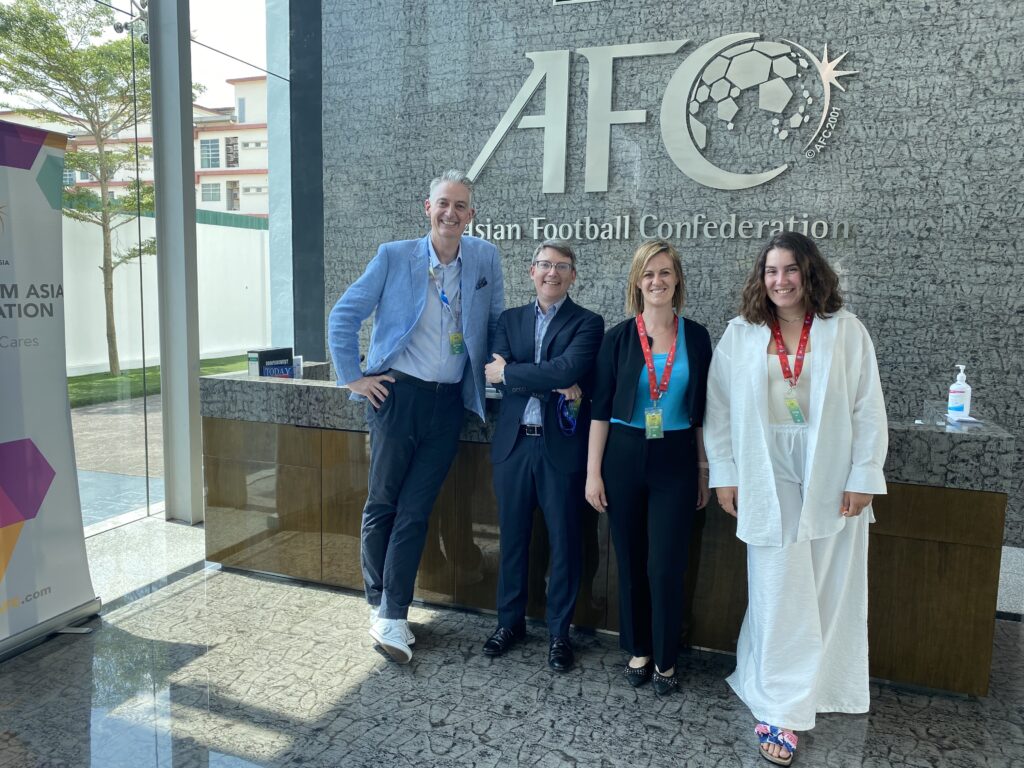Planning an event for a non-profit organization is about purpose, impact, and mobilizing communities. Whether you’re organizing a fundraiser, awareness drive, or conference, effective non profit event planning requires strategic thinking, collaboration, and the right tools. However, nonprofits often face challenges like limited budgets, lean teams, and time constraints, which can make event execution complex and overwhelming.
According to OneCause, 57% of nonprofits say fundraising events generate more than 20% of their total annual revenue, making events one of the most impactful tools for mission funding. Nonprofits generate meaningful revenue through well-executed events, and leveraging modern event technology and strategic planning is essential.
This guide walks you through a comprehensive checklist to help your nonprofit plan and execute successful events from start to finish.
TL;DR
Successful nonprofit event planning starts with a clear purpose, defined goals, and a well-structured team.
Securing sponsorships, managing logistics, and delivering memorable experiences are key to driving engagement and impact.
Post-event follow-ups and proper evaluation ensure continuous improvement and stronger community relationships.
Thoughtful planning improves donor experience, increases fundraising outcomes, and strengthens your nonprofit’s credibility.
Understanding Non Profit Event Planning
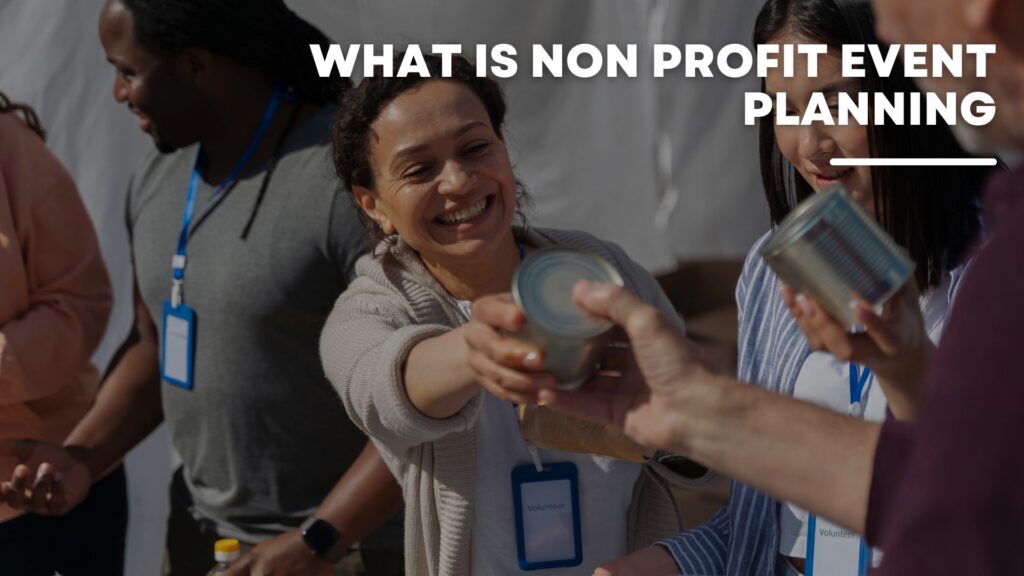
Nonprofit event planning refers to the process of organizing and executing events that support a charitable organization’s mission, be it raising funds, building community awareness, recruiting volunteers, or celebrating milestones.
Unlike corporate events, nonprofit gatherings are typically driven by cause-centric goals and must often be executed with limited budgets and small teams. These events can range from intimate donor meetups and charity runs to large-scale galas and international awareness campaigns.
Effective non-profit event planning involves coordinating logistics, engaging supporters through storytelling, managing volunteers and donors, and executing marketing, all within tight timelines. This is where modern event management software like Wiz Team becomes essential, offering nonprofits flexible, modular tools to manage events smoothly.
Your Complete Checklist for Planning a Successful Nonprofit Event
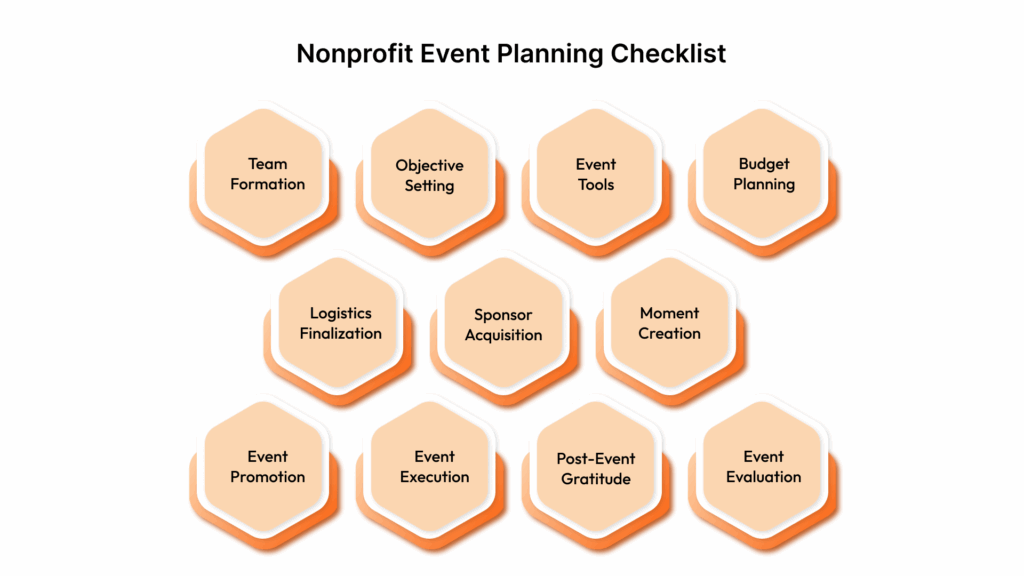
Organizing a nonprofit event is a big undertaking, especially when your team is working with limited resources and high expectations. Having a clear, step-by-step checklist keeps everything on track, from the earliest brainstorming sessions to the final thank-you email.
A structured plan helps avoid last-minute stress, ensures team alignment, and allows your event to make the kind of impact your cause deserves. The checklist below covers every major step in the nonprofit event planning process, helping you stay focused, organized, and in control throughout your journey.
Let’s break it down.
1. Build a Strong Planning Team
Every successful nonprofit event starts with a capable and committed planning team. Choose individuals who understand your mission and bring diverse skills to the table.
Here’s how to build an effective event planning team.
Select the right people: Include staff, volunteers, or board members who are passionate about the cause.
Assign clear roles and responsibilities: Avoid overlap and confusion by dividing responsibilities early. Common roles include:
Event Lead: Oversees overall planning and coordination
Logistics Coordinator: Manages venue, catering, equipment, and permits
Marketing & Promotions Lead: Handles all communication, outreach, and branding
Sponsorship Coordinator: Reaches out to donors, partners, and sponsors
Volunteer Manager: Recruits, trains, and schedules volunteers
Guest Experience Lead: Manages registration, hospitality, and attendee needs
Schedule regular check-ins: Weekly meetings help track progress and stay aligned.
2. Define Clear Objectives and Measurable Goals
Before you start booking venues or designing invitations, take a step back and define the core purpose of your event. Having a clear set of goals ensures your team stays aligned, your message is consistent, and every decision supports your mission.
Here are a few types of goals you can set, depending on what your nonprofit event is aiming to achieve.
Fundraising Goals
If your event’s focus is to generate funds, outline how much you aim to raise overall. This could include revenue from ticket sales, donations, or peer-to-peer fundraising efforts. Set a realistic target based on past performance and current capacity.
Donor Engagement Goals
Beyond raising money, it’s important to strengthen relationships with your supporters. Engagement goals might include acquiring a specific number of new donors, increasing repeat donor participation, or ensuring your team has one-on-one interactions with key attendees.
Education & Program Awareness Goals
For events focused on educating your community, set learning objectives or engagement metrics, like the number of program inquiries received, participation in workshops or sessions, or post-event survey results measuring knowledge gained.
Advocacy and Awareness Goals
For events centered around education or mobilization, consider goals like drawing a set number of attendees, collecting petition signatures, or encouraging participants to contact policymakers.
3. Use Smart Tools to Streamline Your Event Planning
Managing a nonprofit event using spreadsheets, emails, and scattered to-do lists can cause confusion and missed deadlines. Choosing an event management software designed for nonprofits can simplify planning and keep tasks organized.
Instead of juggling multiple systems, opt for an all-in-one platform tailored for nonprofits. A solution like Wiz-Team’s Event-Works helps you simplify and centralize the entire planning process.
Here’s what the right platform should help you with:
Seamless Registration & Check-In: Collect attendee info, manage ticketing, and track who shows up, all in one dashboard.
Volunteer Coordination: Schedule, assign, and communicate with your volunteer team easily.
Accreditation & Access Control: Create secure badges and control entry to different event zones without hassle.
Communication Tools: Send updates, reminders, or personalized emails to attendees, sponsors, and staff.
Real-Time Reporting: Track performance metrics, donor engagement, and event ROI as it happens.
With a reliable system like Event-Works, you create a smoother experience for everyone involved, from donors and volunteers to your internal team. It’s a must-have for any nonprofit aiming to run professional, high-impact events.
4. Set a Realistic and Flexible Budget
Every nonprofit event needs a solid financial foundation, and that starts with a well-planned budget. Without it, even the best ideas can fall short or spiral out of control. Budgeting helps you stay focused, allocate resources wisely, and avoid financial surprises down the line.
Start by mapping out all potential expenses, including both fixed and variable costs:
Venue rental and permits
Catering and refreshments
AV equipment and tech support
Marketing and promotional materials
Event software or platform fees
Décor, printing, and signage
Travel, accommodation, or speaker fees (if applicable)
Once you’ve outlined the basics, add a 10–15% buffer to cover unexpected costs, like last-minute rentals, weather-related changes, or extra supplies.
5. Finalize Event Logistics
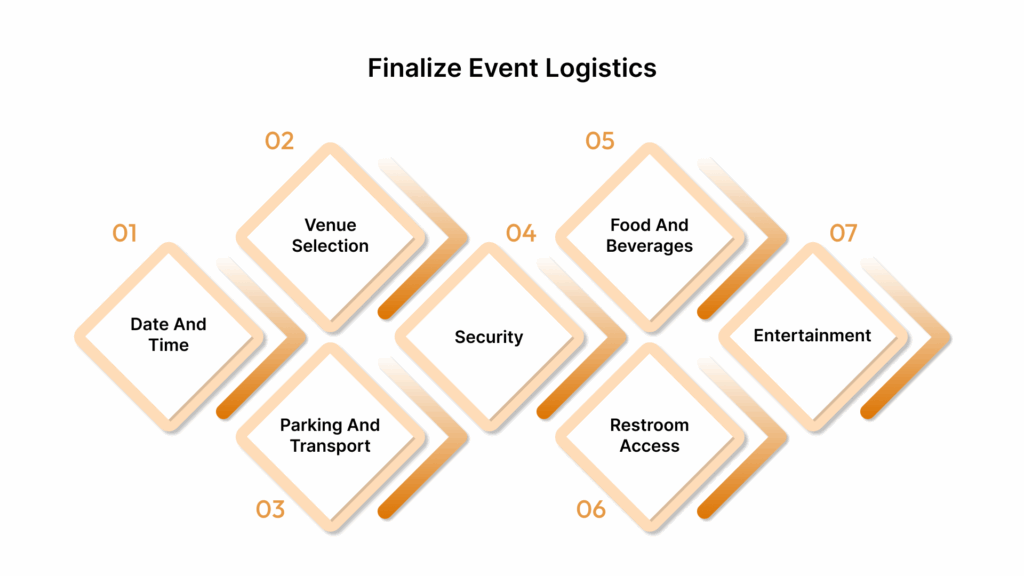
The success of your nonprofit event often depends on the small, behind-the-scenes details. Getting the logistics right ensures your event runs smoothly.
Key logistics to lock in early:
Date and Time: Choose a date that doesn’t clash with other major events in your area. For outdoor events, consider seasonal weather patterns and have a weather contingency plan in place.
Venue Selection: Pick a location that’s accessible, safe, and large enough to accommodate your expected attendees. Always have a backup venue or rescheduling policy if you’re dealing with outdoor or unpredictable spaces.
Parking and Transport: Make sure parking is convenient and well-signposted. If the venue has limited space, look into off-site parking with shuttle services to the event location.
Security: For larger events, partner with a trusted local security firm. Ensure there’s a plan in place for crowd control, emergencies, and safeguarding attendees.
Food and Beverages: Offer food and drink options through vendors, food trucks, or in-house catering. Coordinate with local businesses to provide affordable, crowd-friendly choices.
Restroom Access: Confirm whether your venue includes restrooms. If not, arrange for portable units and make sure they’re cleaned regularly throughout the event.
Entertainment: Enhance attendee engagement by booking entertainment that fits your audience, be it a local band, speaker, or cultural performer.
6. Secure Sponsors and Strategic Partners
Sponsorships play a key role in supporting nonprofit events financially and strategically. When done right, they reduce your costs and enhance your event’s visibility. According to the Cone Communications CSR study, 87% of consumers prefer brands that align with a cause, making nonprofit events a valuable platform for corporate sponsors.
Here’s how to secure meaningful sponsorships:
Target the right sponsors: Focus on companies or foundations that align with your mission or have supported similar causes in the past.
Offer clear sponsorship packages: Create sponsorship levels (e.g., Gold, Silver, Bronze) with clear benefits at each level. These could include benefits like logo placement, social media mentions, on-stage recognition, or booth space.
Personalize your pitch: Reach out with tailored proposals that show how their brand can gain exposure while supporting your mission.
Consider in-kind support: Some sponsors may contribute goods or services, like food, security, or printing, saving your nonprofit money.
Report impact post-event: Share a summary with sponsors showing visibility metrics, photos, and engagement stats to build trust for future collaborations.
7. Create Meaningful Moments
An event may last only a few hours, but the right moments can leave a lifelong impression. For nonprofits, it’s about emotionally connecting with your audience and making your mission feel real. The more memorable the experience, the more likely attendees are to donate, volunteer, or advocate for your cause long after the event ends.
Here are some ways to make your event truly unforgettable.
Start with a story that hits home: Let a beneficiary, volunteer, or frontline worker share their experience. A short, emotional talk or video can instantly connect hearts to your mission.
Bring in guests or performers: Surprise appearances by local influencers, entertainers, or community heroes can add a wow factor and elevate the experience.
Celebrate your supporters: Offer meaningful recognition, like unique gifts or a spotlight moment, for top donors, long-time volunteers, or community partners.
Host creative giveaways or prize draws: Raffle off donated items or experiences to keep the energy up and incentivize engagement. Make sure the prizes feel special and relevant.
Engage through interactive elements: Let attendees contribute to a live mural, share stories on a message wall, or participate in a challenge that ties back to your cause.
End with a powerful call to action: Remind people why they came and how they can keep the momentum going through donations, volunteer work, or advocacy.
Small surprises, genuine emotion, and thoughtful touches can transform a typical gathering into a mission-driven moment your audience won’t forget.
8. Get the Word Out Loud and Clear
No matter how well you plan your event, it won’t succeed without people showing up, and that starts with solid, consistent promotion. The earlier and more effectively you spread the word, the more buzz you’ll build. Promotion is a campaign that needs planning, creativity, and teamwork.
Here’s how to promote your event with purpose.
Craft a clear and compelling message: Your message should clearly define why the event matters and how people can join or support. Keep the tone aligned with your nonprofit’s voice and values.
Use every channel you’ve got: Promote through your email list, social media accounts, website, local newsletters, WhatsApp groups, and printed flyers if needed. Tag sponsors and partners to enhance visibility.
Create a content calendar: Schedule announcements, countdown posts, speaker spotlights, and reminders leading up to the event. Include key dates like early-bird deadlines or limited-time offers.
Tap into your network: Encourage your team, volunteers, partners, and board members to share posts, send invites, or spread the word offline. People are more likely to respond to personal outreach.
Leverage visuals and stories: Use photos, videos, testimonials, or quick reels to make your promotions more engaging and human.
Consistency is key. When everyone, from your staff to your supporters, is echoing the same message across platforms, your event gains traction fast.
9. Make Event Day Count
The day of your event is when all the planning, outreach, and preparation come together. But even with a solid plan, unexpected issues can pop up, so staying calm, flexible, and energized is important.
Here’s how to stay on top of things on the event day.
Kick off with a team huddle: Gather your team and volunteers for a quick check-in. Review the schedule, roles, and emergency contacts. It sets the tone and builds confidence.
Use printed or digital checklists: From setup to breakdown, checklists keep everyone on track. Create one for logistics, one for volunteers, and one for guest experience.
Assign point people or team leads: Have a go-to person for each area, like logistics, hospitality, tech, and volunteer coordination.
Keep communication flowing: Use walkie-talkies, group chats, or a mobile app to stay connected in real time. Quick updates help you adjust timely manner.
Engage with attendees personally: Greet guests, thank them for coming, and ask for feedback. These small moments go a long way in making people feel valued and involved.
Capture the moments: Take photos and short videos of key highlights, guest interactions, and behind-the-scenes moments. These can be used for post-event marketing and thanking sponsors.
A smooth and meaningful event day is about making every person there feel like they’re part of something bigger.
10. Express Sincere Gratitude After the Event
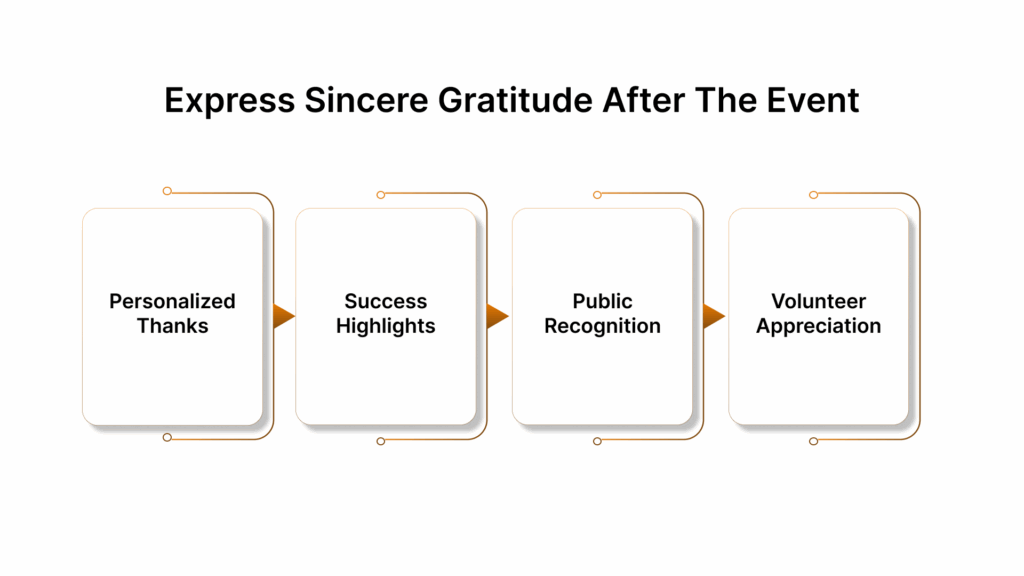
How you follow up can leave just as strong an impression as the event itself. Taking time to thank everyone involved, attendees, volunteers, sponsors, partners, and your internal team, shows professionalism, care, and appreciation.
Here’s how to make your gratitude count.
Send personalized thank-you messages: Whether it’s an email, a handwritten note, or a phone call, make your message specific. Mention the person’s contribution or presence and how it helped support your mission.
Highlight success stories in your follow-up: Share photos, videos, and a brief event recap. Let people know what their support achieved, funds raised, goals reached, or impact created.
Thank sponsors and partners publicly: Tag them in social media posts, include them in your post-event newsletter, and offer shout-outs on your website. Public recognition strengthens partnerships.
Recognize volunteers: Feature standout volunteers in a “thank you” post or spotlight them in your newsletter. A little recognition can go a long way in keeping them engaged.
11. Reflect, Review, and Refine for Next Time
One of the most valuable steps comes afterward. A quick but focused debrief helps your team learn, grow, and improve future events.
Here’s how to evaluate your event effectively.
Host a team debrief within a few days: While the event is still fresh, bring your core team and volunteers together. Discuss wins, challenges, and standout moments. Encourage open and honest feedback.
Review key performance data: Look at registration numbers, attendance rates, funds raised, volunteer turnout, and sponsorship outcomes. Compare these to your original goals to assess impact.
Collect feedback from attendees: Send a short post-event survey asking what they enjoyed, what could be better, and whether they’d attend again. Keep it simple but insightful.
Track engagement and visibility: Measure social media activity, email responses, press mentions, and content shares to see how far your message traveled.
Document lessons learned: Create a short internal report or checklist summarizing what worked and what to adjust.
Post-event evaluation is about building momentum. The insights you gain now will shape smarter, more impactful events in the future.
Why Thoughtful Event Planning Matters for Nonprofits?
For nonprofit organizations, every event is a chance to raise funds, rally supporters, spread awareness, and bring your mission to life. Careful, strategic planning is what turns good intentions into real impact.
Here are some of the key benefits of proper event planning.
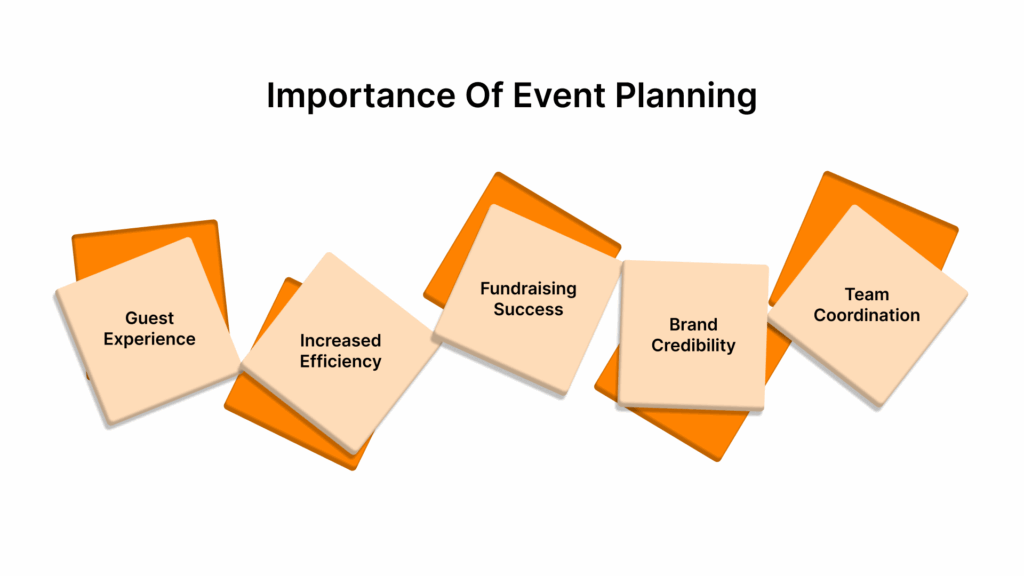
Better donor and guest experience: A well-organized event makes guests feel welcome, informed, and inspired to support your cause.
Increased efficiency: With logistics, roles, and timelines clearly mapped out, your team works smarter.
Higher fundraising results: When every detail is aligned with your fundraising goals, you’re more likely to hit or exceed your targets.
Stronger brand and credibility: A professionally run event builds trust with donors, partners, and the public.
Improved team coordination: Planning reduces confusion and ensures your staff and volunteers know exactly what to do and when.
Smart Planning Practices to Strengthen Your Nonprofit Events
Beyond the basic checklist, strong nonprofit event planning comes down to the mindset and methods behind every decision.
Here are some smart practices that can enhance your planning process.
Learn from past events: Review previous wins and challenges. Use real data and attendee feedback to guide decisions, avoid repeated mistakes, and build on what worked.
Prioritize accessibility and inclusion: Think beyond logistics. Is your event welcoming to people of all backgrounds, ages, and abilities? Make space for diverse voices and experiences.
Keep stakeholders in the loop: Regularly update sponsors, partners, and internal teams with progress, changes, and how their contributions are helping. Clear communication builds stronger relationships and accountability.
Always have a backup plan: Weather issues, tech glitches, or no-shows can happen. Build in a little flexibility and assign someone to handle on-the-spot fixes so the event stays on track.
When you combine mission-driven intent with smart, forward-thinking practices, your nonprofit events become more than organized, unforgettable, and impactful.
Non Profit Event Planning with Event-Works by Wiz-Team
Running a nonprofit event comes with a need to deliver real impact. That’s where Wiz-Team’s Event-Works steps in. Designed by event professionals with years of hands-on experience, Event-Works is a modular, cloud-based platform built to simplify complex event planning without compromising on quality.
Here’s what makes Event-Works a powerful tool for nonprofit event planning.
Customizable Modules: Select only the tools you need, including registration, accreditation, access control, and more, based on your event’s size and goals.
Seamless Guest Experience: Event-Works ensures every attendee, donor, volunteer, or partner has a smooth, informed experience with clear updates, guided schedules, and mobile access throughout your nonprofit event.
Secure Cloud Access: Access your event operations securely from anywhere, anytime. Event-Works runs on a reliable cloud infrastructure with global availability.
Audit Trails & Compliance Features: Maintain transparency and trust with end-to-end data security, full audit logs, and GDPR/CCPA-compliant workflows, ideal for nonprofits handling donor and participant data.
Real-World Impact: Wiz-Team’s Event-Works, in partnership with Fielddrive, powers a self-check-in system for the European Commission, managing over 500,000 visitors annually. With smart kiosks, instant badge printing, and automated access control, it ensures fast, secure, and error-free guest management, ideal for nonprofits running high-traffic or sensitive events.
Conclusion
From setting clear goals to managing volunteers, sponsors, and logistics, every detail plays a role in your event’s success. With a thoughtful checklist and a reliable platform like Event-Works by Wiz-Team, you can spend less time troubleshooting and more time focusing on impact. Plan smart, stay organized, and create events that move your mission forward.
Ready to simplify your next nonprofit event? Talk to Wiz-Team today and discover how Event-Works can transform the way you plan, manage, and deliver nonprofit events.
FAQS
What are the key steps in nonprofit event planning?
Key steps include defining the event’s purpose, setting a budget, selecting a date and venue, promoting the event, and evaluating its success afterward.
What should be included in a nonprofit event checklist?
A comprehensive checklist should cover planning timelines, venue details, marketing strategies, volunteer assignments, and post-event evaluation criteria.
How can I effectively promote my nonprofit event?
Utilize social media, email marketing, local press, and partnerships with other organizations to reach a wider audience and increase attendance.
How do I measure the success of a nonprofit event?
Success can be measured through attendance numbers, funds raised, participant feedback, and the overall impact on your organization’s mission.
What types of events work best for nonprofits?
Fundraising galas, community service days, workshops, and awareness campaigns are popular and effective event types for nonprofits.
How can I engage volunteers for my nonprofit event?
Engage volunteers by clearly defining roles, providing training, recognizing their contributions, and creating a positive and inclusive environment.
How do I recruit sponsors for my nonprofit event?
Approach potential sponsors by highlighting the benefits of partnership, such as brand exposure, alignment with community values, and opportunities for networking.
What are the common challenges in nonprofit event planning?
Challenges may include budget constraints, volunteer management, securing sponsorships, and ensuring adequate attendance, all of which require proactive planning and flexibility.
#WizJourney




